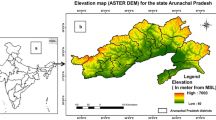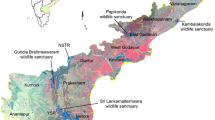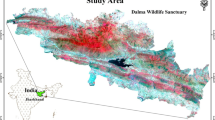Abstract
This is the first of its kind work on the assessment of forest burnt area and fire hotspots of Myanmar using Landsat OLI data and spatial statistics tool. Burnt area analysis indicates 15.2% of vegetation area was affected by fires in 2017. Analysis of burnt area at state level indicates Kayah affected by more fires in 2017. Of the total vegetation fire occurrences from 2003 to 2017 about 44.7% were observed in the forested landscapes of Myanmar. The emerging hotspot analysis had shown the highest spatial extent of persistent hotspots followed by oscillating hotspots. Forest fire hotspots are mainly found in the states of Kayah, Shan, Bago, Nayi Pyi Taw, Magway, Mandalay, Chin, and Kayin. Overall earth observations based on 2003 to 2017 fire occurrences indicate a declining trend of fires in Myanmar. A comparison of the fire occurrences recorded by MODIS and VIIRS indicates that VIIRS is capable of detecting a greater number of fire incidences. The findings of the study would support in assessing the impact of fires on forest, its structure, composition, function, and provide valuable input for nationwide forest fire management.
Similar content being viewed by others
Avoid common mistakes on your manuscript.
Introduction
Occurrence of fire is identified as a prominent disturbance regime that influences biodiversity and global climate change (Rudel et al. 2005). Fires are a threat to biodiversity due to the human fire dynamic variability (Fuller et al. 2004). Ecological impact of fires on forest ecosystems, especially across boreal, temperate and tropical biomes, received global attention (Nasi et al. 2002). The increase in temperature and decrease in rainfall in association with land-use change contribute to the spread of human induced fires in Asia (IPCC 2007). The tropical warmer regions are more vulnerable to fires (McKenzie et al. 2004; Chuvieco et al. 2003).
The increase in edge forests caused by fragmentation will lead to greater fire risk, as agricultural residue burning may spread to these forests. The fire incidences and the distance of the forest edge to the interior are found to be inversely proportional (Nepstad et al. 1999; Cochrane et al. 1999; Cochrane and Laurance 2002). The fire behaviour is also influenced by elevation, slope, and aspect (Harmon 1982; Bennett 2010). Another important anthropogenic causative factor for fires is the distance to roads (Nepstad et al. 2001; Arima et al. 2005). The regeneration and recruitment of many species are affected by fires, and it facilitates the encroachment by invasive species which contributes to forest degradation (Reddy et al. 2014).
The rapid spread of fire is mainly caused by the availability of burnable material, inclination of the terrain, high wind velocity, and soaring summer temperature (Rothermel and Richard 1991; Roy et al. 2006). The existence of highly combustible coniferous vegetation and limited moisture content stimulates isolated trees at higher altitudes and scrubs at lower altitudes to easily catch fire (Gupta et al. 2018). The coarse-resolution sensors such as the Moderate Resolution Imaging Spectroradiometer (MODIS) with thermal infrared bands (3.6–12 µm range) are capable of detecting vegetation fires on a real-time basis (Reddy et al. 2017).
Study Area
Myanmar, an Indo-Burma biodiversity hotspot, situated between 9°32′ N and 28°31′ N latitude and 92°10′ E and 101°11′ E longitude. This country consists of seven states: Chin, Kachin, Kayah, Kayin, Mon, Rakhine, and Shan, mainly covering hill regions and seven divisions − Ayeyarwady, Bago, Magway, Mandalay, Sagaing, Tanitharyi, and Yangon, covering the plains. Myanmar is reported to have a large number of fires in Asia (Vadrevu and Justice 2011). The study reported more than 6 million ha of forest being annually affected by fires in Myanmar (FAO 2006). The work had quantified the factors impacting vegetation fires in protected and non-protected areas of Myanmar (Biswas 2015). Even though Myanmar is reported to be having the highest number of forest fires, no studies were done till date to quantify the forest burnt area and identification of hotspots using spatial statistics. The main objective of this work is to generate a first national database on forest burnt area and hotspots of fires in Myanmar.
Materials and Methods
Data Used
-
1.
Landsat 8 OLI data of 2017 (https://earthexplorer.usgs.gov/).
-
2.
MODIS active fire locations from 2003 to 2017 (https://earthdata.nasa.gov/earth-observation-data/near-real-time/firms/active-fire-data).
-
3.
VIIRS active fire locations from 2016 to 2017 (https://earthdata.nasa.gov/earth-observation-data/near-real-time/firms/active-fire-data).
-
4.
Vegetation type map of 2016 prepared as part of the National Carbon Project (Reddy et al. 2019).
Methodology
Forest Burnt Area Mapping
To estimate the burnt area the 64 cloud-free images from Landsat 8 OLI for the dry season of February to May 2017 were used. In this study vegetation burnt area has been extracted using unsupervised ISODATA classification, normalized burn area ratio, and visual interpretation. In the first step, all the primarily non-vegetated areas were masked out in satellite imagery using spatial data of vegetation cover. Burnt areas have lower spectral values than no burnt areas because of the decreased level of photosynthetic activities. A 3 × 3 matrix was used for performing post-classification smoothening. Raster data were converted to vector format to refine the boundaries of forest burnt areas using visual interpretation techniques. The normalized burn ratio (NBR) is an index designed to highlight burnt areas (Miller and Thode 2007). The formula of NBR combines the use of both near-infrared (NIR) and shortwave infrared (SWIR) wavelengths. A high NBR value indicates healthy vegetation, while a low value indicates bare ground and recently burnt areas. Non-burnt areas are normally attributed to values close to zero.
Emerging Hotspot Analysis
An emerging hotspot analysis is conducted to investigate trends of forest fires over space in addition to trends over time. A space–time cube was created using each of the data layers representing a category of fire counts from MODIS active fire product as the input feature. The emerging hotspot analysis tool takes the space–time cube as input and conducts a hotspot analysis using the Getis–Ord Gi* statistic for each bin. The neighbourhood distance and neighbourhood time-step parameters define how many surrounding bins, in both space and time, will be considered when calculating the statistic for a specific bin. Based on the input parameters, the space–time cube took the attributes values and aggregates all points with a distance interval of 1000 m and a time-step interval of 1 year to create a bin. The sum of all the aggregated data attribute values included in the bin is the attribute value for that bin. This tool uses the Gi* statistic as a measure of the degree of association between the attribute value for each bin within the space–time cube to the spatial weight or relationship with the attribute values of its neighbouring bins (Getis and Ord 1992). With statistically significant high (or low) attribute values being surrounded by other bins with high (or low) attribute values, it then compares the attribute value for a bin and its neighbours to the mean attribute value of all bins. The Gi* statistic returned for each bin in the dataset is a z score or standard deviation. After the Gi* statistic has been computed, hotspot/cold spot trends were analysed using the Mann–Kendall trend test to detect temporal trends at each spatial location with data against time (Mann 1945). Using the calculated hotspot z score and p value for each bin and the trend z score and p value, the emerging hotspot analysis tool classifies each location into one of 17 categories (Zhu and Newsam 2016) (Table 1).
Results and Discussion
Extent of Forest Burnt Area
About 15.2% of vegetation area was affected by fires in 2017. Among the four vegetation types, forests had experienced a high extent of burnt area (Fig. 1). The spatial analysis indicates the highest percentage of burnt area in grassland, followed by scrub and plantations (Table 2). Analysis of burnt area at state level indicates 58.4% of forest in Kayah affected by fires in 2017 (Table 3). Analysis of burnt area across the forest types shows deciduous forests were affected by more fires (Table 4). Error matrix confirms that majority of the classified fire pixels are correct. Overall classification accuracy was achieved at 92.02%, and kappa statistic was above 0.87.
Trend in Fire Occurrences from 2003 to 2017 Based on MODIS
In all the years from 2003 to 2017 a significant number of fires were found in all vegetation classes (Table 5). The number of fire occurrences in forests is found to be the highest than the other vegetation types. The year 2007 is showing the highest number of forest fire occurrences followed by 2010, 2004, and 2012. Overall 15 years of analysis shows declining trend of fires in Myanmar indicates increased conservation measures.
Of the total vegetation fires in 2003–2017, forests accounted for the highest percentage (44.7%) of fire occurrences followed by scrub (19%), plantation (12.8%), agriculture (12.2%), and grassland (11.4%). About 39.7% of fire occurrences were recorded in forests in 2017, followed by agriculture (18%), scrub (17.8%), grassland (13.1%), and plantation (11.4%). The number of fire occurrences is found to be higher in the months of February, March, and April, collectively contributing to more than 90% of fires, while 2.2% of forest fire events were recorded alone in the month of May based on earth observations from 2003 to 2017 (Table 6).
Fire Occurrences Recorded by MODIS and VIIRS (2016–2017)
The comparison of fire incidences recorded by MODIS and VIIRS shows that VIIRS had recorded a highest number of fire incidences. The year 2016 had a greater number of fires in all vegetation classes. Two-year data on fires by VIIRS also show decreasing pattern of vegetation fires in Myanmar (Table 7).
On analysing the monthly fire occurrences again, it is found that the number of fire occurrences are more in February, March, and April (Table 8). The monthly fire incidences recorded for 2016 and 2017 had shown a significant change in the number of fires by VIIRS and MODIS. This change may be attributed to the difference in the spatial resolution of their thermal bands. The thermal band of MODIS has 1000-m resolution per pixel, whereas VIIRS has a 375-m resolution per pixel. This higher resolution enables VIIRS to detect fires that MODIS overlooks. However, VIIRS is a more sensitive instrument when it comes to detecting fires. MODIS provides crisper background images because MODIS has 250-m spatial resolution for other than thermal bands and can produce more detailed land surface images.
Emerging Hotspot Analysis
The emerging hotspot analysis had shown the highest spatial extent of persistent hotspots followed by oscillating hotspots (Table 9). A total of 161 intensifying hotspots and 450 new hotspots were found. About 1545 hotspots out of a total of 17,639 hotspots were found to be diminishing, and 1424 hotspots were found to be historical hotspots. Forest fire hotspots are concentrated mostly in the states of Kayah, Shan, Bago, Nayi Pyi Taw, Magway, Mandalay, Chin, and Kayin (Fig. 2). New hotspots are found only in Tanitharyi. The coastal states of Ayeyarwady, Yangon and snow-covered states of Sagaing and Kachin were least affected by fire (Table 10). The highest area under diminishing hotspots is recorded in Magway.
Conclusions
This work had assessed the annual forest burnt area in Myanmar using Landsat 8 OLI satellite data for 2017. The deciduous forests were found to be more vulnerable to fires. Emerging hotspot analysis had done using MODIS active fire locations to study the spatiotemporal trends of forest fires. Analysis of 15 years of fire occurrences from 2003 to 2017 indicates a declining trend of fires in Myanmar. In a biodiversity-rich country like Myanmar more scientific studies are required to devise fire management plans to minimize the ecological impact of fire events on forest ecosystems.
References
Arima, E. Y., et al. (2005). Loggers and forest fragmentation: Behavioral models of road-building in the Amazon basin. Annals of the Association of American Geographers,95(3), 525–541.
Bennett, M. (2010). Reducing fire risk on your forest property (Vol. 618). Corvallis: Oregon State University Extension Service.
Biswas, S., et al. (2015). Factors controlling vegetation fires in protected and non-protected areas of Myanmar. PLoS ONE,10(4), e0124346.
Chuvieco, E., et al. (2003). Combining NDVI and surface temperature for the estimation of live fuel moisture content in forest fire danger rating. Remote Sensing of Environment,92(3), 322–331.
Cochrane, M. A., & Laurance, W. F. (2002). Fire as a large-scale edge effect in Amazonian forests. Journal of Tropical Ecology,18(3), 311–325.
Cochrane, M. A., et al. (1999). Positive feedbacks in the fire dynamic of closed canopy tropical forests. Science,284(5421), 1832–1835.
FAO. (2006). Global forest resource assessment 2005 progress towards sustainable forest management. Rome: UN Food and Agriculture Organization.
Fuller, D. O., Jessup, T. C., & Salim, A. (2004). Loss of forest cover in Kalimantan, Indonesia, since the 1997–1998 El Nino. Conservation Biology,18(1), 249–254.
Getis, A., & Ord, J. K. (1992). The analysis of spatial association by use of distance statistics. Geographical analysis,24(3), 189–206.
Gupta, S., et al. (2018). Forest fire burnt area assessment in the biodiversity rich regions using geospatial technology: Uttarakhand Forest Fire event 2016. Journal of the Indian Society of Remote Sensing,46(6), 945–955.
Harmon, M. (1982). Fire history of the westernmost portion of Great Smoky Mountains National Park. Bulletin of the Torrey Botanical Club,109, 74–79.
IPCC. (2007). Fourth assessment report of the intergovernmental panel on climate change. Cambridge: Cambridge University Press.
Mann, H. B. (1945). Nonparametric tests against trend. Econometrica: Journal of the Econometric Society,13, 245–259.
McKenzie, Donald, et al. (2004). Climatic change, wildfire, and conservation. Conservation Biology,18(4), 890–902.
Miller, Jay D., & Thode, Andrea E. (2007). Quantifying burn severity in a heterogeneous landscape with a relative version of the delta Normalized Burn Ratio (dNBR). Remote Sensing of Environment,109(1), 66–80.
Nasi, R., et al. (2002). Forest fire and biological diversity. UNASYLVA-FAO,53, 36–40.
Nepstad, D., et al. (1999). Large-scale impoverishment of Amazonian forests by logging and fire. Nature,398(6727), 505.
Nepstad, D., et al. (2001). Road paving, fire regime feedbacks, and the future of Amazon forests. Forest Ecology and Management,154(3), 395–407.
Reddy, C. S., Unnikrishnan, A., Asra, M., Manikandan, T. M., & Jaishanker, R. (2019). Spatial conservation prioritisation of threatened forest ecosystems in Myanmar. Journal of Indian Society of Remote Sensing,47(10), 1737–1749.
Reddy, C. S., et al. (2014). Threat evaluation for biodiversity conservation of forest ecosystems using geospatial techniques: A case study of Odisha, India. Ecological Engineering,69, 287–303.
Reddy, C. S., et al. (2017). Nationwide assessment of forest burnt area in India using Resourcesat-2 AWiFS data. Current Science,112(7), 1521–1532.
Rothermel, R. C. (1991). Predicting behavior and size of crown fires in the Northern Rocky Mountains. Res. Pap. INT-438. Ogden, UT: US Department of Agriculture, Forest Service, Intermountain Research Station. 46 p. 438.
Roy, D. P., Boschetti, L., & Trigg, S. N. (2006). Remote sensing of fire severity: Assessing the performance of the normalized burn ratio. IEEE Geoscience and Remote Sensing Letters,3(1), 112–116.
Rudel, T. K., et al. (2005). Forest transitions: Towards a global understanding of land use change. Global Environmental Change,15(1), 23–31.
Vadrevu, K. P., & Justice, C. O. (2011). Vegetation fires in the Asian region: Satellite observational needs and priorities. Global Environmental Research,15(1), 65–76.
Zhu, Y, Newsam, S. (2016). Spatio-temporal sentiment hotspot detection using geotagged photos. In Proceedings of the 24th ACM SIGSPATIAL international conference on advances in geographic information systems. ACM.
Acknowledgements
The present work has been carried out as part of ISRO’s National Carbon Project. We thank ISRO-DOS Geosphere Biosphere Programme for financial support. We are grateful to Director, NRSC, Deputy Director, RSA, NRSC, and Group Director, NRSC, for suggestions and encouragement. We are thankful to NASA, ESA, and USGS for providing free open access data.
Author information
Authors and Affiliations
Corresponding author
Additional information
Publisher's Note
Springer Nature remains neutral with regard to jurisdictional claims in published maps and institutional affiliations.
About this article
Cite this article
Unnikrishnan, A., Reddy, C.S. Characterizing Distribution of Forest Fires in Myanmar Using Earth Observations and Spatial Statistics Tool. J Indian Soc Remote Sens 48, 227–234 (2020). https://doi.org/10.1007/s12524-019-01072-9
Received:
Accepted:
Published:
Issue Date:
DOI: https://doi.org/10.1007/s12524-019-01072-9






